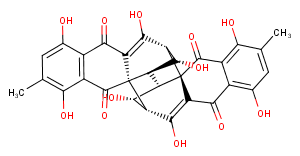Luteoskyrin
| Code | Size | Price |
|---|
| TAR-T32982-5mg | 5mg | £850.00 | |||||||||||||||||||||||||||||||||||||||||||||||||||||||||||||||||||||||||||||||||||||||||||||||||
| Special offer! Add £1 to your order to get a TargetMol CCK-8 Kit. Read more here. | |||||||||||||||||||||||||||||||||||||||||||||||||||||||||||||||||||||||||||||||||||||||||||||||||||
Quantity:
Prices exclude any Taxes / VAT
Overview
Regulatory Status: RUO
Shipping:
cool pack
Storage:
-20℃
Images
Documents
Further Information
Bioactivity:
Luteoskyrin is a hepatotoxic and hepatocarcinogenic bisdihydroanthraquinone produced by Penicillium islandicum Sopp.
CAS:
21884-44-6
Formula:
C30H22O12
Molecular Weight:
574.494
Purity:
0.98
SMILES:
Cc1cc(O)c2C(=O)C3=C(O)[C@@H]4[C@H](O)[C@H]5[C@H]6[C@@H](O)[C@@H](C(O)=C7C(=O)c8c(O)cc(C)c(O)c8C(=O)[C@@]467)[C@]35C(=O)c2c1O
References
1. Masuda T, Ito J, Akuzawa S, Ishii K, Takagi H, Ueno Y. Hepatic accumulation and hepatotoxicity of luteoskyrin in mice. Toxicol Lett. 1992 Jun;61(1):9-20. PubMed PMID: 1609444.
2. Tseng HH, Tseng TC. Effects of naled and dichlorvos on growth and production of Luteoskyrin byPenicillium islandicum. Mycotoxin Res. 1993 Mar;9(1):35-40. doi: 10.1007/BF03192230. PubMed PMID: 23606065.
3. Ueno Y, Ishikawa I. Production of luteoskyrin, a hepatotoxic pigment, by Penicillium islandicum Sopp. Appl Microbiol. 1969 Sep;18(3):406-9. PubMed PMID: 5373676; PubMed Central PMCID: PMC377994.
4. Ueno I, Sekijima M, Hoshino M, Ohya-Nishiguchi H, Ueno Y. Spin-trapping and direct EPR investigations on the hepatotoxic and hepatocarcinogenic actions of luteoskyrin, an anthraquinoid mycotoxin produced by Penicillium islandicum Sopp. Generations of superoxide anion and luteoskyrin semiquinone radical in the redox systems consisted of luteoskyrin and liver NADPH- or NADH-dependent reductases. Free Radic Res. 1995 Jul;23(1):41-50. PubMed PMID: 7647918.



